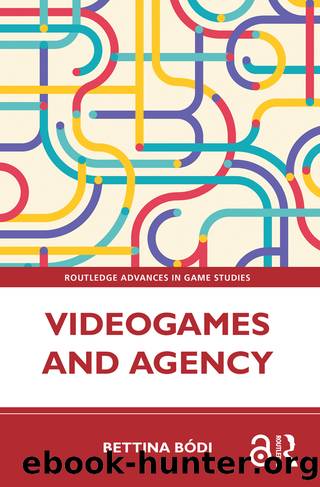Videogames and Agency by Bettina Bódi

Author:Bettina Bódi
Language: eng
Format: epub
Publisher: Taylor and Francis
Published: 2023-08-15T00:00:00+00:00
Narrative-Dramatic Agency in Uncharted 4
Since the gameâs narrative structure is largely linear in its delivery, it does not afford many possibilities for the player to meaningfully intervene in its development. Nevertheless, there are a few branching pints in the narrative, even if regardless of player choice the story returns to its main trajectory. Notably, certain cut-scenes offer dialogue options for the player/avatar to choose from. While these gameplay situations do offer slightly different responses to non-player charactersâ questions, and as such they invite the player to construct slightly different interpretations of storyworld events, the playerâs choices here do not actually result in any alteration of the major plot as designed to be delivered. In a cut-scene from early in the game, for example, Elena catches Nathan Drake wandering off in thought while she tells him about her day, and tests whether he paid attention with a question the player/avatar has to answer. None of the answers provided are actually correct, and there is no way the player could answer them correctly as Elenaâs voice was muffled for the majority of her monologue. All three lead to her reacting the same wayâsarcastically smirking.
As such, we can argue that a very low degree of narrative agency is being afforded through sections such as this. Besides a few more instances like this, most other cut-scenes are more traditional, although Naughty Dog disposed of the black letterbox framing that used to appear in previous instalments. Such framing, remediating filmic traditions of maintaining aspect ratios when transferring widescreen footage to be displayed on screens with different aspect ratios, such as TV, has been typically used in videogames to distinguish cut-scenes from playable sequences in games. Uncharted 4âs disposal of this tradition makes transitions between cut-scene and gameplay even more seamless, blurring the boundary between film-y and game-y sections. The fluency of the resulting gameplay experience is, in a way, more reminiscent of a film-viewing experience.
Besides recalling the âfamiliar voice of a genreâ (Klevjer 2013: 305), cut-scenes in Uncharted 4 make use of further cinematic storytelling tools: acting, mise-en-scene, and cinematography. An example that is rich with such devices appears about halfway through the game, when Nathan Drakeâs wife Elena tracks him down to confront him about a lie. The function of this cut-scene is to convey character emotions and trace changes in relationships, as well as to inform on where each character is heading next. The scene begins with the camera panning out in a long aerial shot of a construction site, which was the scene of the previous gameplay section. This is followed by a wipe scene transition, Star Wars style, to a hotel, which is where the rest of the cut-scene takes place. Here, Nathan Drake and his brother Sam quickly brief their mentor Sully (and with that, the player) on the next mission objective. As the three walk in the hotel room, they find Elena there, standing by the desk, looking at maps and holding letters, which indicates that she discovered the lie, albeit not yet in all its details.
Download
This site does not store any files on its server. We only index and link to content provided by other sites. Please contact the content providers to delete copyright contents if any and email us, we'll remove relevant links or contents immediately.
Cecilia; Or, Memoirs of an Heiress — Volume 1 by Fanny Burney(31353)
Cecilia; Or, Memoirs of an Heiress — Volume 3 by Fanny Burney(30951)
Cecilia; Or, Memoirs of an Heiress — Volume 2 by Fanny Burney(30908)
The Great Music City by Andrea Baker(21637)
We're Going to Need More Wine by Gabrielle Union(18088)
Bombshells: Glamour Girls of a Lifetime by Sullivan Steve(13120)
Pimp by Iceberg Slim(12949)
All the Missing Girls by Megan Miranda(12778)
Fifty Shades Freed by E L James(12465)
Talking to Strangers by Malcolm Gladwell(11910)
Norse Mythology by Gaiman Neil(11904)
Crazy Rich Asians by Kevin Kwan(8374)
Mindhunter: Inside the FBI's Elite Serial Crime Unit by John E. Douglas & Mark Olshaker(7851)
The Lost Art of Listening by Michael P. Nichols(6485)
Enlightenment Now: The Case for Reason, Science, Humanism, and Progress by Steven Pinker(6416)
Bad Blood by John Carreyrou(5784)
The Four Agreements by Don Miguel Ruiz(5534)
Weapons of Math Destruction by Cathy O'Neil(5049)
We Need to Talk by Celeste Headlee(4882)
